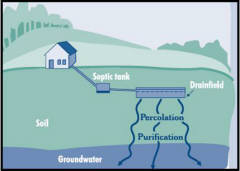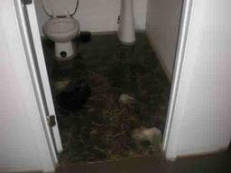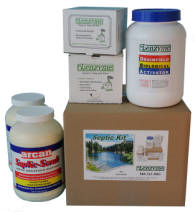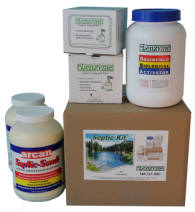


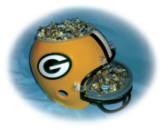
Bio - Products, Packaging & Marketing Experts



All Rights Reserved - Lenzyme - 2010 - 2020
Diagnosing a Septic Tank Drainfield Problem
The most common septic tank failures happen when septic bacteria and septic tank enzymes are killed off in normal septic tanks and aerobic septic tanks by harsh household cleaning chemicals or strong medications homeowners are taking for a serious illness. Another problem area is when septic tank pumps, septic filters, and septic tank aerators break down. All these situations allow septic tank sludge to escape from the septic tank and overload the septic tank drainfield with solids causing the bio-mat to become out of balance.
Here is a list of symptoms associated with septic tank problems or septic drainfield problems:
Slow or sluggish flushing of toilets or drains - septic pipe noises
Drainfield problems or septic tank problems will result in messy cleanups, inconvenient smells and oders, and possibly costly repairs. You don’t want to have the septic tank pump truck in the driveway when you have family or friends invited over for a big party!
Diagnosing a septic tank drainfield problem is difficult, but here is a list of common problems associated with backed up septic drainfields. See our septic education area for list of common problems of a backed up septic tank.
Sludge overloading causing Bio-mat and or sulfite build up (Drainfield bio-mat balancing problem)
“Diagnosing a septic field problem” is a hard thing to do. What kind of septic problem do you have? Learn about the septic system parts and how a septic tank works before you try to come up with a septic remedy.
If you think it is a septic tank failure then review that section of our educational web site. The septic drain field is the most expensive component of the septic tank drainage system, and is the highest septic system cost during septic tank construction. The septic drainfield also has the biggest influence on the septic system life expectancy. Unfortunately, it is the hardest and costliest septic system repair if you have a septic drainfield failure.
Let your ears be your septic helper - listen for pump or high-level water alarms
Septic system odors outside of the building especially above the septic fields or septic tank riser
Wet spots above the septic tank or septic drainfield from septic tank sewage rising to the surface
Actual backups from toilets or other plumbing inside the building
Broken drainfield piping or compacted soil from parking vehicles over the drainfield
Grease causing grease capping, cutting off oxygen in the septic system drainfield
Tree roots in the septic distribution box, septic system pumps, septic media filters, and drainfield
Not enough septic tank pump out or cleanings
Septic systems design outdated causing over capacity issues
Now we will discuss some possible solutions to your septic drainfield problems. These are general guidelines and solutions which are based on our 35+ years of solving septic and drainfield problems through our professional contractor network. Most drainfield problems can be fixed with proven septic drainfield restoration techniques. These techniques sometimes called “remediation” often use a combination of specialized drainfield equipment and “bioremediation” solutions, including high quality septic treatment products. Sometimes the drainfield problems are so bad that it will require removal of the septic tank, installation of secondary treatment septic systems, or installation of partial above ground septic systems. Diagrams for aeriated septic tanks or mound septic systems can help you understand these types of alternative septic systems. These of course are not home repair septic systems, and should be installed by septic professionals who specialize in these types of alternative septic systems. Get out your septic system diagram to locate your septic tank. All the solutions for your septic drainfield problems start with a septic pumper truck which will be used as your septic system cleaner and will also have all the septic system supplies to do the job right.
The good news is most drainfield problems are from bio-degradable solids building up to a point that the drainfield can not handle the volume of water entering the system. This can be corrected and thereby help to extend your septic drainfield life! All is not lost and things can be corrected by using a combination of special equipment and/or products developed for these situations. Make sure to immediately start following the best practices of caring for your septic system because your wastewater needs to be properly treated and purified before reaching the groundwater. If you used cheap septic additives that said you never had to pump your tank again, stop using it and watch the Cat Food Test video to see the difference in quality additives. The goal of repairing a failed drainfield is to remove as many of the solids as possible from within the drainfield drainage piping. Then continue the drainfield restoration process by bioremediation which involves providing enough biological activity, especially septic tank enzymes to breakdown and digest the remaining solids in the piping, seepage bed, and the soil surrounding the drainfield.
Septic drainfield problem:
Grease capping from too much grease entering the septic system.
Solution:
Grease is a problem for plumbing, septic tanks, and drainfields. Septic tank and drainfield systems at federal campgrounds and RV parks, family style campgrounds and RV parks, rural restaurants, and beach front campgrounds are all big problem locations for this type of grease overload. Grease should never be put down the drains leading to your septic system. Because grease is water-soluble it can easily escape the septic tank and build up in the drainfield after it cools and solidifies. This build up is called “grease capping”, and it cuts off any oxygen from reaching the bio-mat. Grease is hard to breakdown but it can be done with the proper biological enzymes. The same solutions we have mentioned for sludge buildup in #1 above will work for grease capping. But you will need a special blend of enzymes and grease eating bacteria to complete the drainfield bioremediation process.
Septic drainfield problem:
Septic did not get enough regular septic tank pump outs and cleanings.
Solution:
As we talked about in the two previous problems sludge buildup in the drainfield needs to be prevented. The good news, it is correctable at a reasonable cost. The black slime containing the sulfite accumulation needs to be removed and the drainfield bio-mat balancing problem solved. High pressure jetting equipment or drainfield treatments using oxidizers are excellent solutions. A good oxidizer can destroy the anaerobic bacteria causing the drainfield bio-mat balancing problem. Once the black slime is destroyed, the natural biological balance can be restored. The septic tank drainfield will be recovered from the injury, but it has to be maintained from now on to keep it working properly.
Septic drainfield problem:
Broken drainfield piping or compacted soil.
Solution:
Compacted soils can be fixed with special equipment such as “soil fracturing” equipment. This type of equipment fractures the soil and allows more oxygen to reach the drainfield seepage bed. It also will give a jump start to the percolation of the drainfield into the surrounding soils. Know the location of your septic tank and drainfield so that you never park any vehicles or build any structures on top of those areas. The drainfield needs to have evaporation happen on the surface, so only low growing vegetation should be planted above a septic system. Never put a driveway or other non-porous surfaces above the drainfield area.
Septic drainfield problem:
Old system designs such as cesspools and seepage pits.
Solution:
We have come a long way in our understanding of wastewater treatment, and there have been many improvements over the last few decades. Sometimes you are unlucky and have a system that is wore out, or was installed without the proper percolation rates for the usage. A new system will be the answer in most cases. However, if you have an older design using a cesspool or seepage pit you don’t necessarily need replacement. It is common for older cesspools and seepage pits to clog quicker than other types of systems. These can often be saved and continue to work perfectly well by using the same solutions we have mentioned for sludge buildup. A good oxidizer works nicely to unclog the cesspool or seepage pit area of those types of older septic systems. The oxidizer works in between the blocks or bricks and also attacks the solids at the bottom of the pit that the pumper truck can not remove. Cesspools and seepage pits can sometime benefit from high pressure jetting of the walls. Use your septic professional to advise you on what will work best for your cesspool septic system.
We recommend and supply (Root control like ROOTX) an environmentally safe treatment that can be applied annually to kill the roots back without killing the tree. This is not an area for the do it yourself septic system owner, root cutting equipment is dangerous and environmental laws have to be followed if you are using certain chemicals. Don’t think you can just go to the local store and buy a small bottle of copper sulfate and dump it into the drainfield and think your root problem will be solved. If root killing treatments are used they need to be applied by a professional who knows what he/she is doing. Most treatments require the drainfield to sit for a few hours to a few days, so you should plan accordingly.
We hope this information has helped you understand the wastewater treatment system you have in your yard. Every drainfield problem is different and not all methods of restoration will work for every situation. We provide proven solutions for your drainfield problems, and we have the network of septic and plumbing professionals who can provide expert service for all your septic and drainfield needs.

Septic drainfield problem:
Sludge and other solids leaving the septic tank without proper treatment.
Solution:
As you know by now this is a bad thing. The question at this point is “How bad is it?” Well that is hard to know for sure. If it is clogged with pieces of plastics and other non-biodegradable solids from sanitary napkins, disposable diapers, cigarette butts, etc then you are probably looking at replacing the drainfield. Sure there are some things that can be done to prolong the inevitable, but you are throwing good money after bad. Just bite the bullet and get it replaced.
Septic drainfield problem:
Clogged drainfields from tree roots.
Solution:
Certain trees like willows can send out roots in every direction and travel long distances to find water. Your septic system and drainfield is the perfect place for them to find the water they are after. Plus the drainfield water is full of nutrients trees and other vegetation love. Of course you can have a tree cutting service come by and cut down the trees affecting your septic system. Root cutting equipment is available to cut the roots off in your drain lines. Another solution is to apply root killing chemicals such as copper sulfate to kill the roots.
